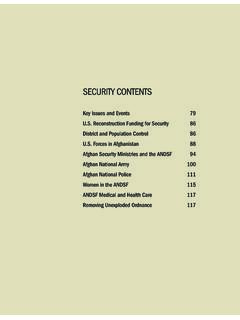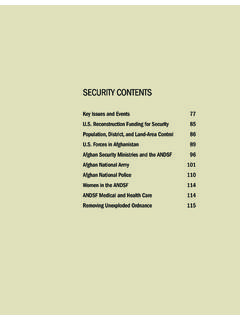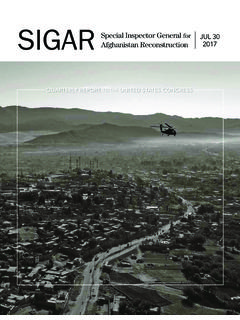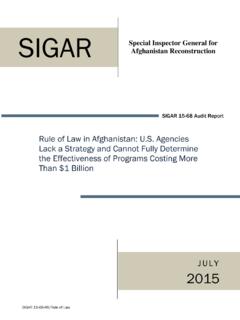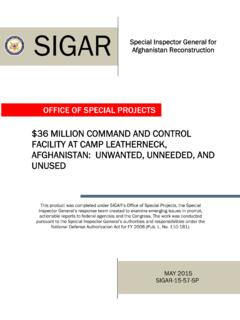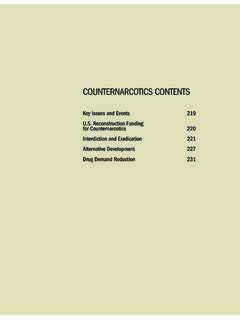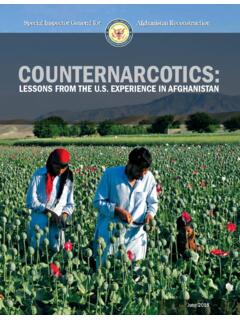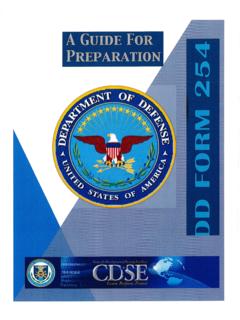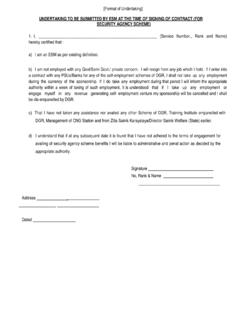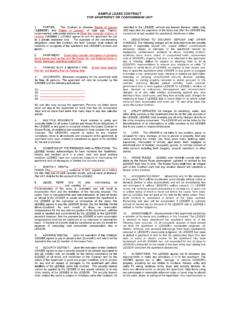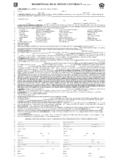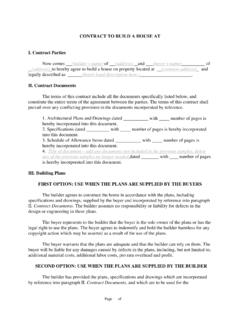Transcription of SIGARAfghanistan Reconstruction
1 SIGAR Special Inspector General for Afghanistan Reconstruction HIGH-RISK LIST. JANUARY 2017. Seabees place prefabricated concrete pieces in the riverbed at the Musa Qal'eh low-water-crossing project. (Navy Photo by Mass Communication Specialist 1st Class Russ Stewart). Cover photo: A Army aviation specialist views Afghan mountains from the back of her Chinook helicopter as another follows on the way from Kabul to Jalalabad. ( Army photo by Spc. Ken Scar). SPECIAL INSPECTOR GENERAL FOR. AFGHANISTAN Reconstruction . I am pleased to present SIGAR's High-Risk List report to the incoming Administration and the new Congress.
2 It identifies what we see as the greatest threats to the ultimate success of our more than 15-year-long Reconstruction effort in Afghanistan. The investment in Afghanistan has been extraordinary. Since 2002, Congress has appropriated more than $115 billion for Afghanistan's Reconstruction . It is the largest expenditure to rebuild a single country in our nation's history. This tremendous amount of taxpayer money has been used to train Afghan security forces, stand up the Afghan government, and develop the local economy.
3 Despite this enormous expenditure, the recon- struction effort remains tenuous and incomplete. and international donors recently pledged to financially support Afghanistan through 2020, with our contribution expected to remain at or near $5 billion a year. The work of SIGAR and other oversight agencies has found that much of the recon- struction mission is at risk. To explain why, SIGAR's High-Risk List report outlines the most critical issues threatening Reconstruction . It also offers key questions for the new Administration and the 115th Congress to consider when crafting policies for addressing these vexing challenges.
4 While all eight risk areas outlined in this report threaten Reconstruction , the questionable capabilities of the Afghan security forces and pervasive corruption are the most critical. Without capable security forces, Afghanistan will never be able to stand on its own. Without addressing entrenched corruption, the legitimacy and effectiveness of the Afghan govern- ment will remain in a perilous state. If these two risk areas are not addressed, I fear that our Reconstruction efforts could ultimately fail, to the detriment of our national- security goals in Afghanistan.
5 SIGAR remains dedicated to its Reconstruction oversight mission in Afghanistan and will continue to aggressively ferret out waste, fraud, and abuse. It is my sincere hope that this High-Risk List report, in conjunction with SIGAR's other oversight work, will help guide Congress and the Administration to ensure a more effective Reconstruction effort in what has become America's longest war. Sincerely, John F. Sopko Special Inspector General for Afghanistan Reconstruction 2530 CRYSTAL DRIVE ARLINGTON, VIRGINIA 22202. JOWZJAN KUNDUZ.
6 BALKH TAKHAR. SAMANGAN. FARYAB BAGHLAN. SAR-E PUL. PANJSHIR. BADGHIS. PARWAN KAPIS. BAMYAN LA. KABUL. HERAT. WARDAK. N. GHOR LOGAR. DAYKUNDI PAKTIYA. GHAZNI KHOW. URUZGAN. FARAH. PAKTIKA. ZABUL. NIMROZ. HELMAND. KANDAHAR. SPECIAL INSPECTOR GENERAL I AFGHANISTAN Reconstruction . TABLE OF CONTENTS. BADAKHSHAN. 2 EXECUTIVE SUMMARY. NURISTAN 4 BACKGROUND FOR THE. SA KUNAR NEW ADMINISTRATION AND CONGRESS. AGHMAN. 11 HIGH-RISK AREAS. NANGARHAR 13 HIGH-RISK AREA 1: Afghan security Forces Capacity and Capabilities 20 HIGH-RISK AREA 2: Corruption 26 HIGH-RISK AREA 3: Sustainability 34 HIGH-RISK AREA 4: On-Budget Support WST 39 HIGH-RISK AREA 5: Counternarcotics 43 HIGH-RISK AREA 6: Contract Management 47 HIGH RISK AREA 7: Oversight 51 HIGH-RISK AREA 8: Strategy and Planning 55 CONCLUSION.
7 Current SIGAR offices Provinces where SIGAR has conducted or commissioned audit, inspection, special project, and/or investigation work as of July 30, 2016. HIGH RISK LIST I JANUARY 11, 2017. EXECUTIVE SUMMARY. In 2014, the Special Inspector General for Afghanistan Reconstruction (SIGAR). developed a High-Risk List to call attention to program areas and elements of the Reconstruction effort in Afghanistan that are especially vulnerable to significant waste, fraud, and abuse. This High-Risk List has been updated to identify and address systemic problems facing Reconstruction efforts in Afghanistan.
8 The report highlights program areas where SIGAR believes implementing agencies need to focus. It also discusses how specific agencies are failing to mitigate risks in areas that involve their operations. The current report differs from the 2014 report in that it has separated contract management and oversight into two areas in recognition of the increased risk to both. The eight current high-risk areas are: AFGHAN security FORCES CAPACITY AND CAPABILITIES. Afghanistan needs a stable security environment to prevent it from again becoming a safe haven for al-Qaeda or other terrorists.
9 More than half of all Reconstruction dollars since 2002 have gone toward building, equipping, training, and sustaining the Afghan National Defense and security Forces (ANDSF). However, the ANDSF has not yet been capable of securing all of Afghanistan and has lost territory to the insurgency. As of August 28, 2016, USFOR-A reported that only of the country's districts were under Afghan govern- ment control or influence a reduction from the 72% as of November 27, Capability gaps in key areas such as intelligence, aviation, and logistics are improving, but still hinder CORRUPTION.
10 Corruption continues to be one of the most serious threats to the Afghanistan Reconstruction effort. Corruption has eroded state legitimacy, weakening the government's ability to enlist popular support against the insurgency, discouraging foreign investment and economic growth, as well as seriously diminishing Afghan military capability. SUSTAINABILITY. Much of the more than $115 billion the United States has committed to Reconstruction projects and programs risks being wasted because the Afghans cannot sustain the invest- ment financially or functionally without massive, continued donor support.
